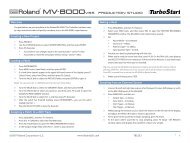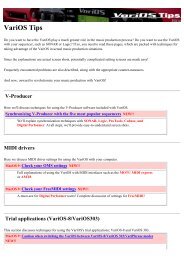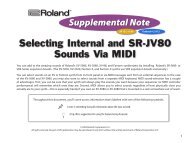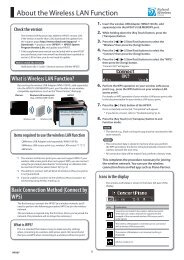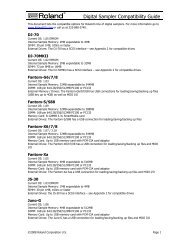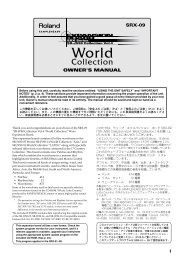Create successful ePaper yourself
Turn your PDF publications into a flip-book with our unique Google optimized e-Paper software.
Chapter 1. Overview of the XP-30<br />
Moving the Cursor (underline)<br />
When two or more items are shown in a single display page,<br />
move the cursor (underline) to the item whose value you<br />
wish to set. Press [ ] to move the cursor to the left, or [ ]<br />
to move it to the right.<br />
fig.1-14<br />
[0]–[9] (Numeric Keys)<br />
[0]–[9] (Numeric Keys) lets you directly specify a numerical<br />
value. When you enter the number, the value will blink. This<br />
indicates that the value has not yet been finalized. To finalize<br />
the value press the ENTER button. To reverse the sign of the<br />
number (+/-), hold down [SHIFT] and press [0].<br />
A symbol appearing in the upper right of the display<br />
indicates that there are other items in this page that the<br />
screen has no room to show. Press [ ] to see these items,<br />
and press [ ] to return to the previous display.<br />
fig.1-15<br />
* Some parameters do not require you to press [ENTER] to<br />
finalize the value.<br />
< Example 1: To enter a value of 38 ><br />
Press [3] → press [8] → press [ENTER]<br />
< Example 2: To enter a value of -60 ><br />
While holding down [SHIFT] press [0] → press [6] → press<br />
[0] → press [ENTER]<br />
Chapter 1<br />
■ Modifying a Value<br />
To modify a value, use the VALUE dial, [INC]/[DEC] or [0]–<br />
[9] (numeric keys).<br />
fig.1-16<br />
* Each parameter has a specific range, so you cannot set any value<br />
smaller than the minimum value or greater than the maximum<br />
value.<br />
VALUE Dial<br />
Rotating the VALUE dial clockwise increases the value,<br />
counterclockwise decreases the value. Holding down<br />
[SHIFT] as you move the VALUE dial increases value<br />
increments so you can make large value changes faster.<br />
[INC] and [DEC]<br />
Pressing [INC] increases the value, and [DEC] decreases it.<br />
Keep [INC] or [DEC] pressed for continuous adjustment. For<br />
faster value increases, keep [INC] pressed down and press<br />
[DEC]. For decreasing value faster, keep [DEC] pressed<br />
down and press [INC].<br />
If you press [INC] or [DEC] while holding down [SHIFT], the<br />
value increments will get bigger.<br />
* You can switch from a positive to negative numerical value<br />
anytime before you press [ENTER].<br />
Special Functions of the Numeric Keys<br />
You can use the numeric keys to specify non-numerical<br />
settings for some parameters.<br />
* For the procedure of using the Numeric Keys to enter the<br />
characters or symbols in a name, refer to “Assigning a<br />
Name” (p. 46).<br />
Performance/Patch/Rhythm Set Group<br />
In the PLAY displays of Performance mode/Patch mode/<br />
Rhythm Set mode, you can use the numeric keys to specify<br />
groups. To specify the group, hold down [SHIFT] and press<br />
numeric keys to specify groups.<br />
Buttons<br />
Group<br />
[SHIFT]+[1] PR-A (preset A)<br />
[SHIFT]+[2] PR-B (preset B)<br />
[SHIFT]+[3] PR-C (preset C)<br />
[SHIFT]+[4]<br />
PR-D (GM (General MIDI))<br />
[SHIFT]+[5] PR-E (preset E)<br />
[SHIFT]+[6]<br />
USER (user)<br />
Restoring a Previous Value (Undo)<br />
If you wish to restore a value to its immediate previous<br />
value, press [UNDO/COMPARE] to return the value to its<br />
pre-modified state.<br />
The Undo function can be used when modifying sound<br />
source settings.<br />
45





